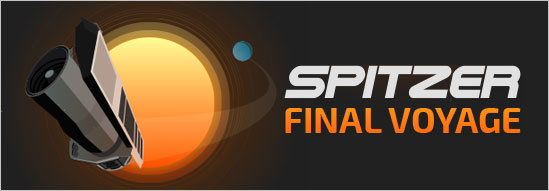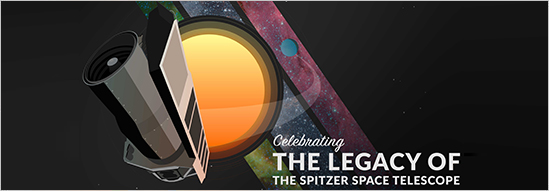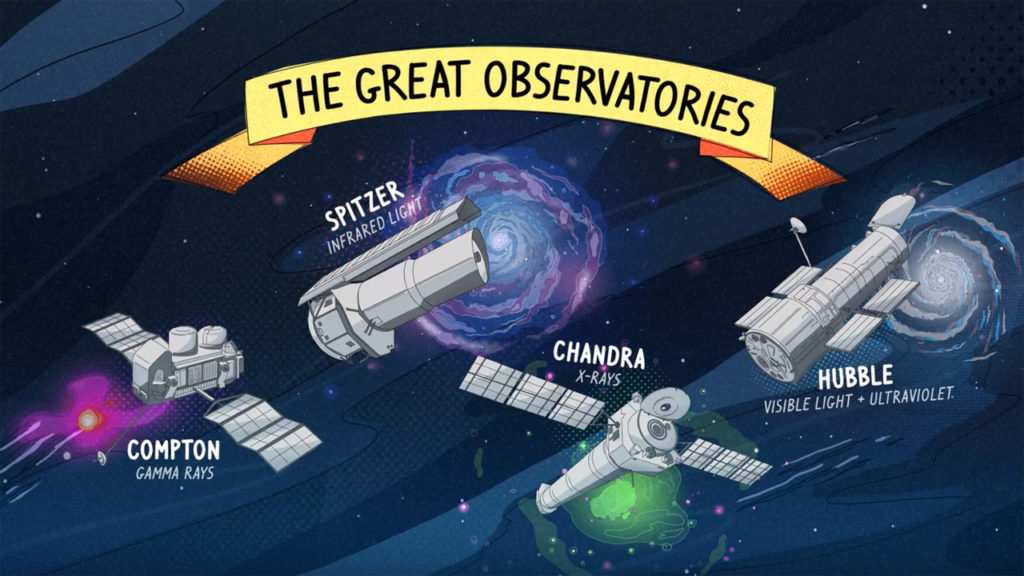

As noted in my post on X-rays, looking beyond what our eyes can see – seeing what is hidden to visible light – tells a better cosmic story. Multi-wavelength observations refine and extend our view of the universe beyond our familiar vision.
So, today we celebrate the Spitzer space telescope, one of NASA’s great space robot observatories; and how infrared astronomy has advanced our understanding of the universe. For example, spectroscopic discoveries regarding the distribution and properties of interstellar dust.
The Spitzer Space Telescope (SST), formerly the Space Infrared Telescope Facility (SIRTF), is an infrared space telescope. It was launched in 2003 (25 August 2003) [and entered service on 18 December 2003] and is planned to be retired on 30 January 2020.
The planned mission period was to be 2.5 years with a pre-launch expectation that the mission could extend to five or slightly more years until the onboard liquid helium supply was exhausted. This occurred on 15 May 2009. Without liquid helium to cool the telescope to the very low temperatures needed to operate, most of the instruments are no longer usable. However, the two shortest-wavelength modules of the IRAC camera are still operable … and have continued to be used to the present in the Spitzer Warm Mission.
The mission is operated and managed by the Jet Propulsion Laboratory and the Spitzer Science Center, located on the Caltech campus in Pasadena, California.
NASA plans to send a shutdown signal to the telescope from the Goldstone Deep Space Communication Complex instructing the unit to reboot into safe mode; as planned, following the reboot, the telescope will send back a signal to confirm this state, and then will be allowed to drift indefinitely.
Spitzer’s mission is ending due to the challenges of heat and power management in a heliocentric “earth-trailing” orbit. Spitzer’s batteries, like your smartphone’s, require recharging. Unlike your smartphone, Spitzer depends solely on sunlight to do so. And like your smartphone, the number of working hours on a full charge declines over time. And pointing the spacecraft so scientists can receive data drains the batteries.
Another aspect of the Beyond mission [begun on 1 October 2016] are the engineering challenges of operating Spitzer in its progressing orbital phase. As the spacecraft moves farther from Earth on the same orbital path from the Sun, its antenna must point at increasingly higher angles to communicate with ground stations; this change in angle imparts more and more solar heating on the vehicle while its solar panels receive less sunlight.
Wiki recaps some of Spitzer’s accomplishments. Recently Space.com (among others) has been celebrating the mission as well. Here’re some references. See the full articles for visualizations and videos such as this mission highlights one.
• Space.com > “Farewell, Spitzer Space Telescope! NASA shuts down prolific observatory” by Doris Elin Urrutia (January 30, 2020) – It saw light that humanity could never see.
One of NASA’s great telescopes will go offline today (Jan. 30) after 16.5 years of observations that helped to paint a more complete picture of the universe.
Spitzer’s science activity came to an end yesterday (Jan. 29) and its mission team will put the spacecraft into a permanent hibernation mode today (Jan. 30). After the final command, Spitzer will continue its trajectory that takes it farther away from the Earth over time, where team members think it will eventually crash into a debris field, according to mission team remarks during NASA’s Jan. 22 news conference.
• Space.com > “The Spitzer Space Telescope’s greatest exoplanet discoveries of all time” by Elizabeth Howell (January 30, 2020)
One of Spitzer’s greatest contributions was its discoveries about exoplanets, or worlds beyond our solar system. Although exoplanet study was not Spitzer’s primary task, the telescope made some incredible planetary finds. Here are 10 of the greatest ones, as selected by NASA.
• Space.com > “NASA is turning off the Spitzer Space Telescope. Its infrared eye changed our view of the universe” by Meghan Bartels (January 29, 2020)
“It was just exquisite, the type of data that Spitzer allowed us to observe,” Farisa Morales, an astrophysicist at NASA’s Jet Propulsion Laboratory in California, told Space.com. “It unveiled the universe: the old, the cold and the dusty.”
In general, Morales is most interested in the ways Spitzer has shown us that our solar system isn’t so special after all. She’s struck by the similarities between our neighborhood and those studied by the observatory. “There’s structure: there’s belts, there’s gaps, and likely baby planets may be forming within them,” she said.
• Space.com > “Gallery: The infrared universe seen by NASA’s Spitzer Space Telescope” by Space.com Staff (January 28, 2020)
[Helix Nebula, Supernova Remnant HGH 3, Penguin and Egg Galaxies, The Sombrero Galaxy, Carina Nebula, The Cat’s Paw Nebula, Dumbbell Nebula, Cepheus Stars and Green Nebulas, Orion Unveiled, Green Nebula Ring, Spiral Galaxy Spider Web, …]
• Cnet > “NASA’s retiring Spitzer telescope snaps wild last view of Tarantula Nebula” – The Spitzer Space Telescope is riding off into the sunset, but not before gifting us with a gorgeous nebula glamour shot – by Amanda Kooser (January 28, 2020) [21 photos]
NASA went back to the telescope’s beginnings when it chose to revisit the Tarantula, which was one of Spitzer’s first observation targets. “That region has a lot of interesting dust structures and a lot of star formation happening, and those are both areas where infrared observatories can see a lot of things that you can’t see in other wavelengths,” said Spitzer project scientist Michael Werner.
• phys.org > “Tarantula Nebula spins web of mystery in Spitzer image” by Calla Cofield, Jet Propulsion Laboratory (January 27, 2020)
Infrared light is invisible to the human eye, but some wavelengths of infrared can pass through clouds of gas and dust where visible light cannot. So scientists use infrared observations to view newborn stars and still-forming “protostars,” swaddled in the clouds of gas and dust from which they formed.
Located in the Large Magellanic Cloud—a dwarf galaxy gravitationally bound to our Milky Way galaxy—the Tarantula Nebula is a hotbed of star formation. In the case of the Large Magellanic Cloud, such studies have helped scientists learn about rates of star formation in galaxies other than the Milky Way.
• Space.com > “It’s time to say goodbye to NASA’s Spitzer Space Telescope. Here’s why” by Meghan Bartels – It’s one of NASA’s Great Observatories (January 22, 2020)
… Spitzer’s struggle comes from trying to balance charging its battery, communicating with Earth and keeping its instruments cool. … the longer the mission continued, the bigger a challenge it became.
“One of the unique things about Spitzer that makes this all possible is its orbit,” Dodd said. Spitzer orbits the sun, tagging along behind Earth and slipping a bit farther away from us each year. “It’s drifting from the Earth and the moon, so it’s not getting the infrared radiation that the Earth and moon system create.” Without that interference, Spitzer can gather better data.
But eventually, that orbit means the spacecraft will be on the opposite side of the sun from Earth for a long period of time — a clear no-go for space communications. Right now, Spitzer is about a third of an orbit behind Earth, so the sun isn’t yet blocking communications.
The farther Spitzer lags behind Earth, the more dramatically the spacecraft has to twist itself in order to communicate back to its scientists. That stresses the spacecraft’s solar-charged batteries, Rebull said, and when they finally get to recharge, the batteries warm up.
The more the spacecraft twists, the more sunlight reaches part of the spacecraft that are supposed to stay cool. The longer the mission continues, the more time Spitzer scientists lose to this process. “You have to wait for the batteries to recharge and then everything to cool down again before you can keep observing,” Rebull said.
Eventually, the spacecraft won’t be able to make that maneuver at all, she added — it would run out of power while sending data back to Earth.
• Space.com > “The Spitzer Space Telescope will shut down Jan. 30. NASA celebrates its legacy this week” by Meghan Bartels (January 19, 2020)
The telescope was tailored to study infrared light, which is often associated with heat. Spitzer was particularly good at peering through the dust that clouds the vision of many other instruments.
That talent has let scientists study the dusty reaches of the cosmos, where stars and planets are still forming. Spitzer has also offered insight into how stars die, how the universe formed and how supermassive black holes feed themselves.
NASA YouTube videos
• “Spitzer and NASA’s ‘Great Observatories’ Space Telescopes” (January 30, 2020) [3′]
• “The Universe in Infrared: The Legacy of the Spitzer Space Telescope” (Streamed live on January 22, 2020) [59′]

